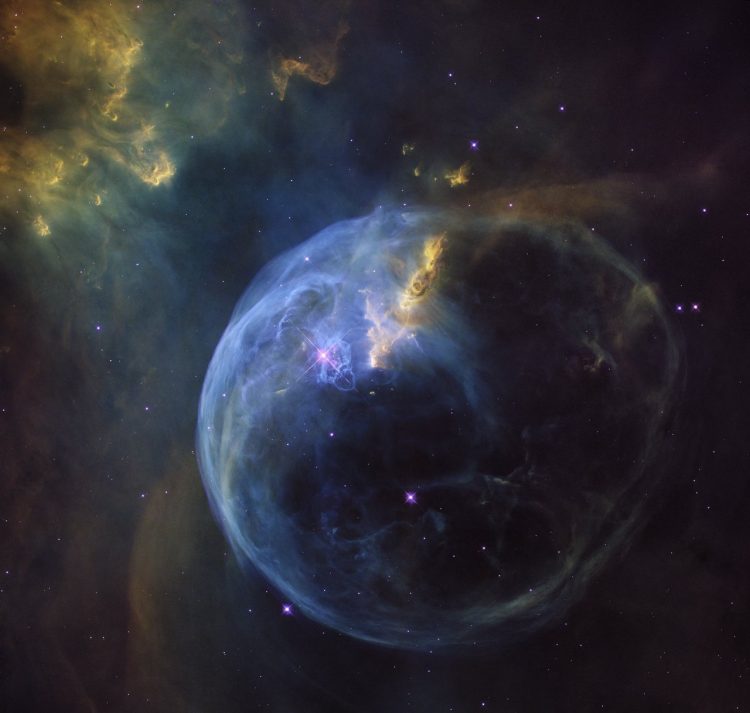Hubble captures birthday bubble

The Bubble Nebula, also known as NGC 7635, is an emission nebula located 8 000 light-years away. This stunning new image was observed by the NASA/ESA Hubble Space Telescope to celebrate its 26th year in space. Credit: NASA, ESA, Hubble Heritage Team
Twenty six years ago, on 24 April 1990, the NASA/ESA Hubble Space Telescope was launched into orbit aboard the space shuttle Discovery as the first space telescope of its kind. Every year, to commemorate this momentous day in space history, Hubble spends a modest portion of its observing time capturing a spectacular view of a specially chosen astronomical object.
This year’s anniversary object is the Bubble Nebula, also known as NGC 7635, which lies 8 000 light-years away in the constellation Cassiopeia. This object was first discovered by William Herschel in 1787 and this is not the first time it has caught Hubble’s eye.
However, due to its very large size on the sky, previous Hubble images have only shown small sections of the nebula, providing a much less spectacular overall effect. Now, a mosaic of four images from Hubble’s Wide Field Camera 3 (WFC3) allows us to see the whole object in one picture for the first time.
This complete view of the Bubble Nebula allows us to fully appreciate the almost perfectly symmetrical shell which gives the nebula its name. This shell is the result of a powerful flow of gas — known as a stellar wind — from the bright star visible just to the left of centre in this image.
The star, SAO 20575, is between ten and twenty times the mass of the Sun and the pressure created by its stellar wind forces the surrounding interstellar material outwards into this bubble-like form.
The giant molecular cloud that surrounds the star — glowing in the star’s intense ultraviolet radiation — tries to stop the expansion of the bubble. However, although the sphere already measures around ten light-years in diameter, it is still growing, owing to the constant pressure of the stellar wind — currently at more than 100 000 kilometres per hour!
Aside from the symmetry of the bubble itself, one of the more striking features is that the star is not located at the centre. Astronomers are still discussing why this is the case and how the perfectly round bubble is created nonetheless.
The star causing the spectacular colourful bubble is also notable for something less obvious. It is surrounded by a complex system of cometary knots, which can be seen most clearly in this image just to the right of the star.
The individual knots, which are generally larger in size than the Solar System and have masses comparable to Earth’s, consist of crescent shaped globules of dust with large trailing tails illuminated and ionised by the star. Observations of these knots, and of the nebula as a whole, help astronomers to better understand the geometry and dynamics of these very complicated systems.
As always, and twenty six years on, Hubble gives us much more than a pretty picture.
The Hubble Space Telescope is a project of international cooperation between ESA and NASA.
Image credit: NASA, ESA, Hubble Heritage Team
Mathias Jäger
ESA/Hubble, Public Information Officer
Garching bei München, Germany
Tel: +49 176 62397500
Email: mjaeger@partner.eso.org
Media Contact
More Information:
http://www.spacetelescope.org/news/heic1608/?langAll latest news from the category: Physics and Astronomy
This area deals with the fundamental laws and building blocks of nature and how they interact, the properties and the behavior of matter, and research into space and time and their structures.
innovations-report provides in-depth reports and articles on subjects such as astrophysics, laser technologies, nuclear, quantum, particle and solid-state physics, nanotechnologies, planetary research and findings (Mars, Venus) and developments related to the Hubble Telescope.
Newest articles

Superradiant atoms could push the boundaries of how precisely time can be measured
Superradiant atoms can help us measure time more precisely than ever. In a new study, researchers from the University of Copenhagen present a new method for measuring the time interval,…

Ion thermoelectric conversion devices for near room temperature
The electrode sheet of the thermoelectric device consists of ionic hydrogel, which is sandwiched between the electrodes to form, and the Prussian blue on the electrode undergoes a redox reaction…

Zap Energy achieves 37-million-degree temperatures in a compact device
New publication reports record electron temperatures for a small-scale, sheared-flow-stabilized Z-pinch fusion device. In the nine decades since humans first produced fusion reactions, only a few fusion technologies have demonstrated…





















